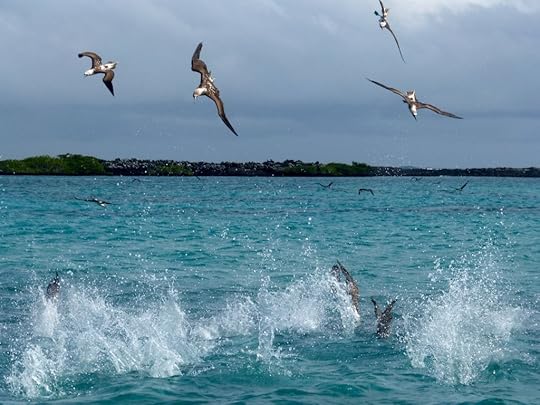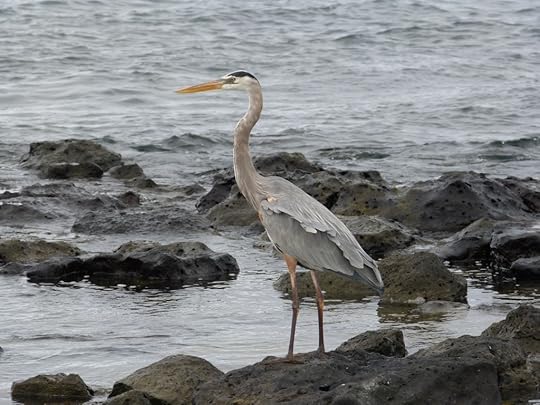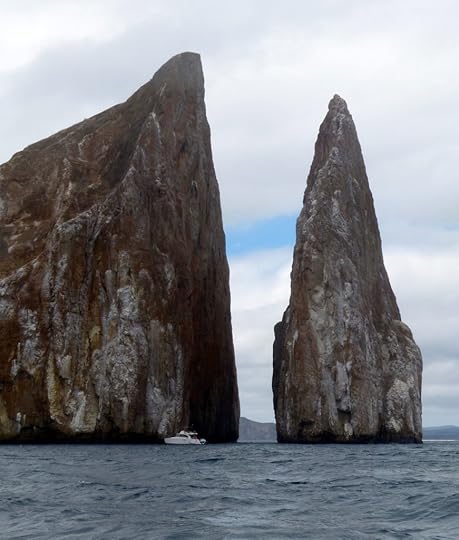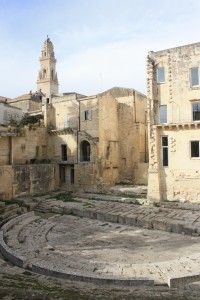Lisa Niver's Blog: We Said Go Travel, page 324
April 19, 2015
USA TODAY: Farmer’s Daughter
 Farmer’s Daughter Hotel: A Retro Property in the Fairfax District
Farmer’s Daughter Hotel: A Retro Property in the Fairfax DistrictThis 1960s-inspired stay also offers on-site restaurant TART for your dining pleasures
By Lisa Niver
Los Angeles Local Expert
DECEMBER 2, 2014
Farmer’s Daughter Hotel in Los Angeles is a 1960s retro property in the historic Fairfax district, featuring TART restaurant for your dining pleasures. This “shabby-chic” location has been redesigned to appeal to the indie, artistic community that frequents this neighborhood.
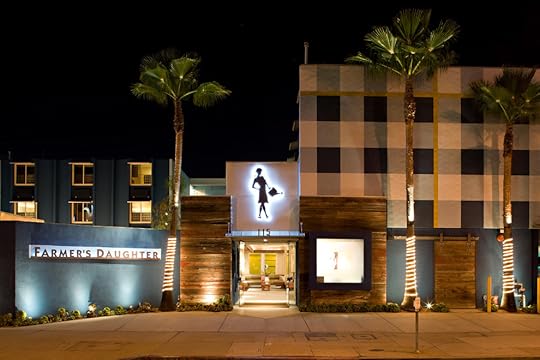 Enjoy nightlife at the Farmer’s Daughter Hotel
Enjoy nightlife at the Farmer’s Daughter Hotel
Photo courtesy of Farmer’s Daughter Hotel
At the Farmer’s Daughter Hotel — located across from The Grove and farmer’s market — you can find everything you need on-site or within a few blocks. The Farmer’s Daughter Hotel was remodeled in 1997 and updates to its exterior and guestrooms are slated for completion in mid-2015.
The public spaces at Farmer’s Daughter beckon you to belong and hang out in the game room with billiards or ping-pong, in the lobby or by the elevator on the comfy couches. There’s even a picnic table and a pool with rubber duckies.
Whether you need a tech-savvy room for a business trip or a place to hang out and relax after a day of touring, you’ll find sociable settings that will make you think, “Only in LA.”
 Discover the newly renovated Robin Room at the Farmer’s Daughter
Discover the newly renovated Robin Room at the Farmer’s Daughter
Photo courtesy of Lisa Ellen Niver
Investigate the recently renovated Robin Room, decorated in robin’s egg blue wallpaper, with custom-made furniture from Java, Indonesia and grasscloth-wrapped walls. The huge mirror and cheeky transparent wall between bedroom and bathroom may give you ideas about what to do with the Farmer’s Daughter.
Ask to stay in the “No Tell Room,” with a copper-encased mirror above the bed, a full landscape mural and a full wet bar.
Guests rave about the complimentary whisky happy hour and bikes to explore the surrounding area. The hotel offers homemade chocolate chip cookies each afternoon around 3 p.m., as well as fresh iced tea and kettle barbecue potato chips. Each room has bathroom treats from C.O. Bigelow from New York City and Nespresso coffee machines.
Tempt your taste buds on site at TART, with buttermilk fried chicken and waffles with Tabasco-maple butter. Sit inside or out by the fire pit, and relax under the stars and twinkling strung lights.
The all-day menu has many Southern-style shareable snacks and entrees, including steak tartare “scotch egg,” heirloom tomato salad and spicy barbecue long beans. Try a basket of biscuits for brunch with waffles and French toast, and build your own omelets to finish.
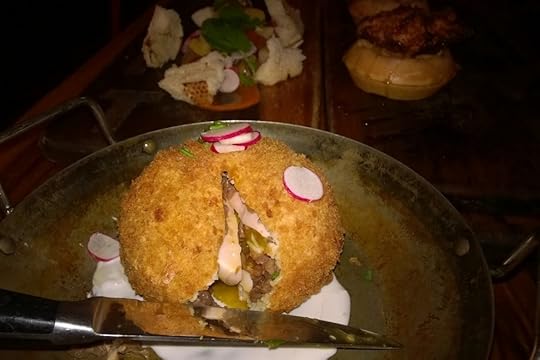 Taste the scotch egg at TART
Taste the scotch egg at TART
Photo courtesy of Lisa Ellen Niver
The cocktail menu is served in mason jars to continue the downhome theme. TART’s many signature, spiked seasonal punchbowls are worth investigating: Scouts Honor with High West Campfire whiskey, apple brandy, orange bitters and a sugar cube; Southern Orange Tree with Ketel one vodka, orange, Serrano bitters and cranberry; or Whole Family Punch with peach vodka, Champagne and orange.
Farmer’s Daughter is a playful yet chic haven for Southern California visitors and locals. Come join the family.
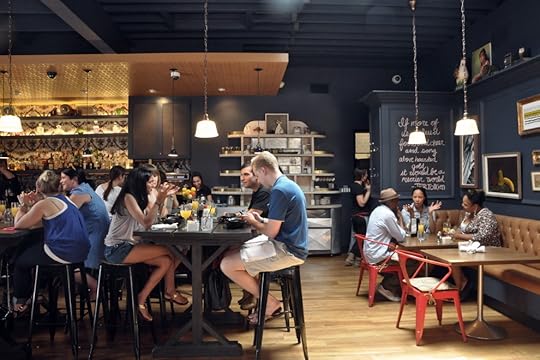 TART’s interior patio is ready for you. Come join in the fun!
TART’s interior patio is ready for you. Come join in the fun!
Photo courtesy of TART Restaurant
The post USA TODAY: Farmer’s Daughter appeared first on We Said Go Travel.
April 18, 2015
On The Move In The Galapagos
I feel a special affinity for the giant tortoises of the Galapagos. Like me, they are large and slow. Unlike me they are green, a hue I only achieve when I’ve had too much to eat or drink. They also live a very long time, well over 100 years on the average. Maybe that’s the trade-off –- move slowly, live long. I can only hope.
I met the tortoises, plus a bunch of other animals, many unique to the islands, on a recent land-based, multi-sport adventure run by Adventure Life, my hosts on this trip. Unlike the more familiar and popular ship-based tour, this trip was active, very active. If we weren’t hiking, we were kayaking. If not kayaking, then biking. Plus lots of snorkeling. To paraphrase a bit from Woody Allen’s movie Annie Hall, my wife and I — true geezers at ages 69 and 72 — believe that like the sharks of the Galapagos, we would sink to the bottom of the ocean and die if we ever stop moving.
The activity was great, but the animals are still the main attraction in the Galapagos. Among my other favorites were the sea lions, which swam alongside our kayaks on a morning paddle along the coast of San Cristobal Island, our first stop on the trip. Alfredo, our guide, said that they were attracted by the colorful kayaks; I think that they mistook me for one of their own — large, mustached and grey.
We also saw lots of birds — gulls, frigates, boobies, finches, pelicans and herons — and iguanas, some of the most bizarre-looking creatures I have ever seen.
The best snorkeling of our trip was at Kicker Rock, a 400? high spire of sedimentary rock jutting out of the ocean a couple of miles off shore. The rock is split in two, creating a narrow channel between steep walls of rock that extend about 60’ below the water.
As we snorkeled through the channel the eerie dark canyon beneath me evoked foreboding images of horror movies yet to be filmed. Sharks, sea turtles, and lots of big fish swam past or lurked beneath. Sea lions whizzed by within a foot of my nose. Snorkeling will never be the same after this.
We also hiked and biked on our six-day adventure. One hike, on San Cristobal, took us up to and around a lake in the caldera of a volcano. The flora and atmosphere in the highlands is quite different than it is by the sea. The islands are mostly desert — very dry with lots of cactus and sparse vegetation — but the highlands are in the clouds, so the vegetation is greener, more dense and lush. The hike around the lake on a mud-slicked trail was like a walk through the moors of Scotland. The low brush looked like heather, and the trail was shrouded in mist the entire way.
Another hike, this one on Isabela Island, took us to the rim of Sierra Negra, the second largest active caldera in the world, five miles across at its widest point. This ten mile round trip hike had a little bit of everything – a seriously muddy uphill trail for the first mile, a fog shrouded hike along the rim, a spectacular view into and across the huge caldera when the fog lifted, and a sunny hike across a lava field to a sweeping view of the ocean from the turnaround point at the end of the trail.
Our bike excursion was also on Isabela Island, a three hour round trip ride to the Wall of Tears, built by prisoners by hand and stone by stone in a penal colony on the island in the 1940s.
Now, I don’t mean any disrespect for the prisoners who suffered and died building this wall, but the tears on this ride were all mine, at least metaphorically. The road to the Wall of Tears is mostly gravel and sand with many rises and dips. For a cycling amateur like me, it was a real challenge. In any case I made it, but only after a lot of sweating, burning thighs, aching knees and a nether region rendered numb from the hard seat.
The day ended with happy hour at a beach bar about 100 yards from the hotel. This gave me an opportunity to observe the mating rituals of another Galapagos animal, though one not unique to these islands. Post adolescent humans displayed their plumage and cleavage and demonstrated their fitness for procreation by playing beach volleyball. No doubt, the double shots of happy hour tequila sharpened my observational skills.
The highlights of Santa Cruz Island, the last island we visited, were the El Chato Tortoise Reserve and the Charles Darwin Research Center. At El Chato, the natural habitat of the largest species of tortoise in the Galapagos, we walked for over an hour among these fantastic animals, often up close and eye-to-eye.
The Research Center was impressive for what it represents as well as for its exhibits. It is a tribute to the scientist who changed our world. In effect, the islands, its people and institutions have turned Darwin into a national hero. In this era of celebrity worship, anti-intellectualism and political dumbing down, its great to see a scientist treated with as much reverence as a rock star.
We can learn a lot from the Galapagos, and not just about the evolution of the blue-footed booby.
(For more information on this trip go to the blog on Don’s website)
The post On The Move In The Galapagos appeared first on We Said Go Travel.
April 17, 2015
Hollywood: Your Home Away from Home Part 2
Part Two: A night out in Hollywood is many people’s dream come true! I recommend dinner at the Bowery, a show at Pantages and a night at the Redbury, “Your Home Away From Home!” (Part One: click here)
VIDEO: The Redbury Hotel Hollywood
From the Redbury: “Situated at the iconic intersection of Hollywood and Vine, our all-suite, luxury hotel in Los Angeles, CA offers an unpretentious refuge with all the comforts you need to unwind after hitting your favorite Hollywood arts, music, fashion and entertainment hotspots.”
I enjoyed my stay at the Redbury and think you truly will feel at home (or better!).
Looking for “Your Home Away From Home” in #Hollywood? @TheRedbury is the answer!
A photo posted by Lisa Niver (@wesaidgotravel) on Apr 1, 2015 at 9:24am PDT
A suite @theredbury is full of creature comforts: A Chic and stylish living space, kitchen, balcony even a washer & dryer. “Your home away from home” rocks at Hollywood and Vine. A photo posted by Lisa Niver (@wesaidgotravel) on Apr 1, 2015 at 9:29am PDT
A photo posted by Lisa Niver (@wesaidgotravel) on Apr 1, 2015 at 9:36am PDT
A secret swanky outside spot inside @TheRedbury find your cozy couch and cocktail before or after dinner or a show @Hollywood and Vine A photo posted by Lisa Niver (@wesaidgotravel) on Apr 1, 2015 at 9:35pm PDT
A photo posted by Lisa Niver (@wesaidgotravel) on Apr 1, 2015 at 9:39pm PDT
The post Hollywood: Your Home Away from Home Part 2 appeared first on We Said Go Travel.
April 16, 2015
Hollywood: Your Home Away from Home Part 1
Part One: A night out in Hollywood is many people’s dream come true! I recommend dinner at the Bowery, a show at Pantages and a night at the Redbury, “Your Home Away From Home!”
VIDEO: A Night out in Los Angeles the Bowery and Pantages Theater
From the Bowery: “The Bowery brings to Los Angeles its first New York style Bar & Bistro. With a comfortable and cozy environment, a serious liquor bar, an eclectic wine list, craft beers and a comforting bistro menu, the Bowery is the quintessential New York joint.”
I think the food especially the hamburgers are AMAZING! Move this to the top of your list of must trys!
Ready for @BowerySt best burgers in #LosAngeles! Hollywood @discoverla
A photo posted by Lisa Niver (@wesaidgotravel) on Mar 31, 2015 at 7:37pm PDT
Best mac’n cheese! @boweryst with @meanmangoliz YUM! A photo posted by Lisa Niver (@wesaidgotravel) on Mar 31, 2015 at 7:40pm PDT
My vote for best burger with caramelized onions @BowerySt! Truly tempting and tasty!
A photo posted by Lisa Niver (@wesaidgotravel) on Mar 31, 2015 at 7:48pm PDT
Amazing! Chocolate pecan pie @boweryst. Delicious and nutritious! A photo posted by Lisa Niver (@wesaidgotravel) on Mar 31, 2015 at 8:06pm PDT
Enjoying the energy & enthusiasm of #Newsies @Pantages
A photo posted by Lisa Niver (@wesaidgotravel) on Mar 31, 2015 at 9:28pm PDT
Discover @Disney #Newsies #Pantagestheatre great show to see with @MeanMangoLiz A photo posted by Lisa Niver (@wesaidgotravel) on Mar 31, 2015 at 10:48pm PDT
The post Hollywood: Your Home Away from Home Part 1 appeared first on We Said Go Travel.
April 15, 2015
Celebrate at Spaghettinis Beverly Hills: With A+ Service, Food & Music
With so many choices in Los Angeles, where do you go for a truly special occasion?
Celebrate at Spaghettinis Beverly Hills! You will be delighted with A+ Service, Food & Music! This is where I brought my mom for her birthday. Incredible sounds, tastes and service will make your night one to remember.
VIDEO: Jennifer Keith Sextet
From Spaghettinis: “A Chef and a Saxophonist walk into a bar…and they hit every note! Inventive California cuisine with Italian sensibilities meets world-class entertainment. Welcome to Spaghettini & the Dave Koz Lounge.”
A sensational start to Saturday night @spaghettinibeverlyhills with Marchese Antinori
A photo posted by Lisa Niver (@wesaidgotravel) on Apr 11, 2015 at 9:07pm PDT
Terrific Trotolle with zucchini, yellow squash, asparagus and caper. Happy birthday mom! Thanks Chef Scott. Great start for celebrating! A photo posted by Lisa Niver (@wesaidgotravel) on Apr 11, 2015 at 9:18pm PDT
A photo posted by Lisa Niver (@wesaidgotravel) on Apr 11, 2015 at 9:44pm PDT
Amazing music with Jennifer Keith & the phenomenally talented sextet @spaghettinibeverlyhills A photo posted by Lisa Niver (@wesaidgotravel) on Apr 11, 2015 at 10:03pm PDT
The post Celebrate at Spaghettinis Beverly Hills: With A+ Service, Food & Music appeared first on We Said Go Travel.
April 14, 2015
Orbitz Press Release: Bermuda with Richard and Lisa
 Orbitz Launches “Orbitz Originals: Bermuda – Proper Fun” in Partnership With the Bermuda Tourism Authority
Orbitz Launches “Orbitz Originals: Bermuda – Proper Fun” in Partnership With the Bermuda Tourism AuthorityBy GlobeNewswire, January 13, 2015, 11:29:00 AM EDT
Online Video Series Highlights the Island’s Many Attractions for Fun-Seeking Travelers
CHICAGO, Jan. 13, 2015 (GLOBE NEWSWIRE) — Leading online travel company Orbitz Worldwide (NYSE: OWW) has partnered with the Bermuda Tourism Authority to launch “Orbitz Originals: Bermuda – Proper Fun,” a seven-part online video series that is co-hosted by award-winning travel experts Richard Bangs and Lisa Ellen Niver and is available for viewing atOrbitz.com/Bermuda. Supported by hotel discounts of up to 20 percent and substantial flight and hotel package savings, this eleventh installment of the “Orbitz Originals” series once again uses the power of online video to inspire travelers and increase bookings to this beautiful Atlantic destination located less than two hours off the East Coast of the U.S.
Research continues to point to the importance of destination video content in consumers’ purchasing behavior. YouTube has seen views of travel content spike by 118 percent year-over-year, according to a recent study and whitepaper released by Google.1 The study also found that two out of three U.S. consumers watch online travel videos when they’re thinking about taking a trip, and that “searches on YouTube generally occur earlier in the travel-planning process…a strong video strategy can help brands reach, inspire and engage today’s digitally savvy traveler in more ways than ever before.” “Orbitz Originals: Bermuda – Proper Fun,” shows off the tropical paradise’s many accommodations and activities, created to entice travelers to take a trip and experience it all for themselves.
Select highlights from the seven-part series:
“Proper Fun in Bermuda” gives viewers an overview of all that the island has to offer, from its pink sand beaches and world-class golf courses to its fine dining and many ways to unwind.
“Proper Food, Only in Bermuda” explores the tide-to-table and farm-to-fork local dining scene, with its authentic flavors of the sea and luxurious drinks and desserts.
“Bermuda Luxury Hotels” contains Richard’s “Gold List” of the top hotels, resorts and spas on the island.
“Scooting Around Bermuda” showcases the island’s 21 square miles on scooter and offers breathtaking views and sights.
 “Short of visiting the island, there’s no better way to showcase Bermuda’s brilliance than video storytelling. Orbitz Originals brings the beauty and experience of Bermuda to a new generation of travelers – and the videos are designed to inspire them to make their next trip to the island,” said Victoria Isley, chief sales & marketing officer at the Bermuda Tourism Authority. “As a trusted media partner and travel brand, Orbitz can also assist in the booking of those trips. From cliff jumping at Admiralty House Park and shopping the styles of the City of Hamilton to sipping a Rum Swizzle at the Swizzle Inn and enjoying a bite of the famous Art Mel’s Spicy Dicy fish sandwich, the options for having ‘Proper Fun’ in Bermuda are endless.”
“Short of visiting the island, there’s no better way to showcase Bermuda’s brilliance than video storytelling. Orbitz Originals brings the beauty and experience of Bermuda to a new generation of travelers – and the videos are designed to inspire them to make their next trip to the island,” said Victoria Isley, chief sales & marketing officer at the Bermuda Tourism Authority. “As a trusted media partner and travel brand, Orbitz can also assist in the booking of those trips. From cliff jumping at Admiralty House Park and shopping the styles of the City of Hamilton to sipping a Rum Swizzle at the Swizzle Inn and enjoying a bite of the famous Art Mel’s Spicy Dicy fish sandwich, the options for having ‘Proper Fun’ in Bermuda are endless.”
To date, “Orbitz Originals” videos highlighting Cancun, the Cayman Islands, Qatar Airways, Vermont, Western Ireland, New York, Northern Ireland, Bradenton, Florida, Puerto Rico, and Jackson Hole have been viewed over 1.2 million times by travelers seeking inspiration for future trips. Bookings to those destinations have experienced double-digit growth over the life of each campaign.
“We want each new edition of the ‘Orbitz Originals’ series to really capture the destination and use video to provide a unique perspective and inspire travelers to visit,” said Josh Winkler, Orbitz Worldwide vice president of partner marketing. “In the case of Bermuda, Richard and Lisa combine their travel expertise to provide a fun look at this popular destination and give travelers a real sense of life on the island.”
1Travel Content Takes Off on YouTube, Google and Ipsos MediaCT (August 2014)
About Orbitz.com
Orbitz.com is a leading travel website that enables consumers to search for and book a broad range of hotels, flights, car rentals, cruises, vacation packages and destination activities. Since launching in June 2001, Orbitz.com has become one of the world’s largest online travel sites. Orbitz.com now offers the groundbreaking Orbitz Rewards loyalty program—the only program where customers can earn rewards immediately on flights, hotels and packages, and redeem instantly on tens of thousands of hotels worldwide. Use the Orbitz Rewards Visa® Card to earn even more rewards. Orbitz.com is the #1 way to book travel on mobile devices, be it using our apps (get them at orbitz.com/mobile) or our smartphone-optimized website (m.orbitz.com), both of which are tailored for smartphones and tablets. The Orbitz app won the 2014 Appy Award for best travel app. Orbitz also ranks #1 in Online Travel Website Customer Satisfaction in the 2014 American Customer Satisfaction Index. Follow Orbitz on Facebook, Twitter and through the Orbitz Travel Blog. Orbitz.com is operated by Orbitz Worldwide (NYSE:OWW).
About Orbitz Worldwide
Orbitz Worldwide (NYSE:OWW) is a leading global online travel company using technology to transform the way consumers around the world plan and purchase travel. Orbitz Worldwide operates the consumer travel planning sites Orbitz (orbitz.com), ebookers (ebookers.com), HotelClub (hotelclub.com) and CheapTickets (cheaptickets.com). Also within the Orbitz Worldwide family, Orbitz Partner Network (orbitzpartnernetwork.com) delivers private label travel technology solutions to a broad range of partners including some of the world’s largest airlines, bank loyalty programs and travel agencies, and Orbitz for Business (orbitzforbusiness.com) delivers managed travel solutions for companies of all sizes. Orbitz Worldwide makesinvestor relations information available at investors.orbitz.com.
Just under two hours from East Coast gateway cities, Bermuda stretches for 21 miles along turquoise waters and is surrounded by a 200-square-mile coral reef plateau. The destination’s accommodations range from luxury resorts to intimate guest cottages and family-run inns, all incorporating the sophistication and hospitality unique to the Bermuda experience. The island includes more than 150 restaurants to fit any traveler’s budget, from simple and inexpensive to elegant and special dining. Bermuda’s diverse activities offer an array of vacation options all year round, including more wreck dives and more golf per square mile than anywhere else in the world, renowned deep sea fishing, luxurious spas and smooth pink beaches. For information visit www.gotobermuda.com, www.facebook.com/BermudaTourism or www.twitter.com/GoToBermuda.
CONTACT: Media contacts:
Orbitz WorldwideTrevor Kight
+1 312-260-8198
trevor.kight@orbitz.com
Bermuda Tourism
Turner PR
Lauren Ryback
212-889-1700
lauren.ryback@turnerpr.com
Source: Orbitz Worldwide
The post Orbitz Press Release: Bermuda with Richard and Lisa appeared first on We Said Go Travel.
April 11, 2015
L’Ile de Noirmoutier, In Search of The World’s Most Expensive Potato
by Paige Donner
Every year in France, when a certain season sets in, namely the Fall, a whole cadre of culinary enthusiasts await with bated breath their chance to devour cèpes and truffles and other richly aromatic tubers and funghi.
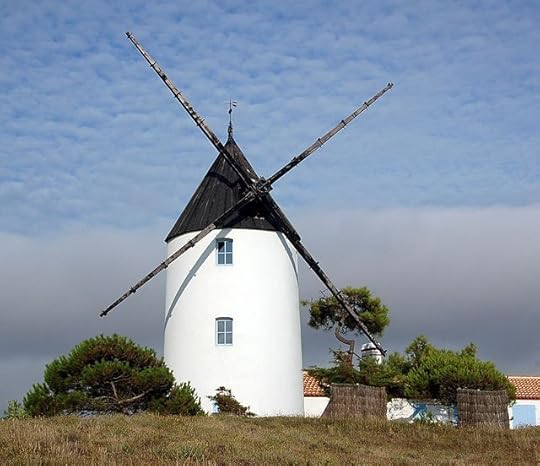 Windmill on the Islandof Noirmoutier, Northern France, Photo courtesy wikimedia Taxiarchos228
Windmill on the Islandof Noirmoutier, Northern France, Photo courtesy wikimedia Taxiarchos228And while I enjoy these produits de terroir immensely, it is in May when this same sort of culinary fever washes over me in anticipation of the first tastes of the little yellow diamond, harvested by hand only, called La Bonnotte.
La Bonnotte, for those of you not familiar with it, is a little yellow gem that grows on the small, sheltered Isle of Noirmoutier in France’s northwest region of the Vendée. And while myself and other culinary gourmands can easily mistake this little tuber for the Royal Star of Paris diamond, it is, in fact, entirely edible. Yes, this little tuber is a potato.
 Photo courtesy Tourist Office, Ile de Noirmoutier
Photo courtesy Tourist Office, Ile de NoirmoutierBut this little tuber isn’t like other little potatoes. Its taste, its consistency, its peak ripeness which lasts but a week, 10 days maximum, is highly prized and when brought to market is sold at Paris’ high-end art auction house, Drouot, in a partnership with luxury fine foods company, Petrossian, known primarily for their caviar.
And this brings us to the absolute perfect pairing for La Bonnotte, the little yellow hand-harvested potato grown exclusively on L’Ile de Noirmoutier: caviar.
La Bonnotte and Caviar
It is said that the only diet Jaccqueline Kennedy Onassis ever put herself on was a caviar-and-potato- once-a-day diet. I have not yet found a specific reference to the potato she used to frame her caviar, but I imagine it could very well have been La Bonnotte.
The first time I had the gastronomic privilege of tasting one of these treasures was at a reception held by LVMH. It was years ago and had something to do with fashion. Therefore, in a gesture of feeding a room full of beautiful people who don’t eat, it struck me as genius that they would serve a tiny little potato garnished with a dollop of fine black caviar, complemented with a touch of fresh Normandy clotted cream on top. Trust me. You have never had a mouthful of finger food so good.
Certainly, a company like LVMH can afford to serve guests the world’s most expensive potato. Coming in at around €500 per kilo, it often outranks even truffles in terms of price category. But for the unitiated eye, all attention was paid to the caviar. An irony, when, in fact, it was La Bonnotte which reigned supreme in the culinary hierarchy there with that caviar pairing.
What is the magic of La Bonnotte and what makes it so expensive?
Firstly, the Bonnotte is a Garden Potato. It demands as much attention from the grower as does a flower from a gardener. I’ve already mentioned two of its other hot-house qualities, namely that it must be hand-harvested and that it grows in a very particular soil, richly fertilized with wrack, whose mineral richness is found exclusively in this particular composition on the micro-climate, sunny northern part of the picturesque Ile de Noirmoutier. It is planted on February 2nd (France’s Candlemas Day) and precisily 90 days later it is in peak condition, taste-wise, and ready for harvesting.
A Brief History of La Bonnotte
The Bonnotte enjoyed an early success and is even credited with helping to build the reputation of The Isle of Noirmoutier. While its exact origins remains a debate between credit going to the Conquistadors who brought this little potato back from the Incas, to a Norman planter endowed with particular potato cultivating savoir-faire, it is generally accepted that in the 20’s or 30’s of the last century, a grower brought back to his island a particular potato from the Barfleur region on the English Channel. The growing conditions, with its briny sea-salt air and rich soils fertilized with wrack, proved exceptional for La Bonnotte and the little potato was crowned supreme by the French agricultural classification, DIEHL in 1938.
This is their description of La Bonnotte:
DIEHL – Its tubers have smooth, yellow skin and dark yellow flesh, finely grained. They are round, and the eyes are semi-sunken. The plant is sizeable and upright with a pigmented stalk and fairly short leaves, marked with a very glossy dark green. The leaflets have an embossed aspect. The flowers are small and white, and the fruits are reddish. It is resistant to potato wart and also, it seems, to degeneration disease. Its period of dormancy is quite long and it is also fairly slow to sprout – a delay it catches up on later.
Mechanization Meant No More
But when mechanization came to the island in the 60’s, La Bonnotte suffered. Its low yield of 100g to 200g per foot meant that farmers could not make a decent return and with their conversion from handpicking to mechanization, other tuber varieties won out. This is why it disappeared altogether from the market by around 1965.
However, because Ile de Noirmoutier had become so famous from its Early Potato variety of La Bonnotte, a group of farmers were determined to resuscitate it. In the ’90s, the Agricultural Co-Operative of the Isle of Noirmoutier went to the INRA (French National Institute of Agricultural Research) in Brest and asked them to regenerate exact copies of La Bonnotte. This replication was highly successful and yielded this little potato that is true in taste as well as form.
“Now part of the agricultural heritage, La Bonnotte is an undeniable element of the island’s identity.”
The farmers of The Isle of Noirmoutier harvest 11,000 tons of potatoes a year from an agricultural area of 380 hectares. But only a very small fraction of these are La Bonnotte. Other popular varieties are the Sirtéma, the Lady Christ’l, Charlotte and Jazzy varieties.
But it is La Bonnotte harvested only between May 1st and May 10th that is the best known product of these farmers here on Ile de Noirmoutier, along with the island’s farmed sea salt. The other Early Potatoes, a category to which La Bonnotte belongs, are harvested between late April and early August and are defined as a potato that is fluffy because of the fineness of its skin and because it’s harvested before it reaches maturity.
Where To Stay: Autre Mer, a 2-star Hotel just past the town center. It has that Nantucket feel with reasonable rates and a friendly owner-operator.
32 Avenue Joseph Pineau, Noirmoutier en L’Ile
Notable: The Bicyle Rental Shop, Cycles Charier, is just across the street. Bicycling is a must while visiting the island. It’s the primary method of transport.
The Isle of Noirmoutier Agricultural Co-Operative
The post L’Ile de Noirmoutier, In Search of The World’s Most Expensive Potato appeared first on We Said Go Travel.
April 5, 2015
A road trip through the Argentine wine country
South America is one of the best places in the world for a road trip. The huge continent has it all; the most pristine and luscious rainforest in the world, postcard perfect beaches, wetlands the size of small countries, unspoiled natural wonders and spectacular mountains second only in height to the Himalayas. To go along with the landscape, the distinct and unique cultures as well as the wide variety of cuisine across the continent are also a great reason to take a journey to South America. Overall, there are a million reasons to take an expedition down south, but no road trip through South America is complete without spending a few weeks of your trip through the wine country in the heart of Argentina.
The best city to use as a base for exploring the Argentine wine country is Mendoza. The town is nestled against the eastern edge of the Andes Mountains, a few hours flight due west of the capital, Buenos Aires. The scenery around the beautiful countryside of Mendoza is absolutely stunning, with the Andes Mountains as a fantastic backdrop. The vineyards spread out over the area are responsible for producing over 80% of the grapes grown in Argentina and boasts over 395,000 acres of vineyards. Overall, there are approximately 1,500 independent vineyards spread out over the country; each producing a unique tasting wine. The vineyards range from small, independent wineries that have been producing wine for hundreds of years to huge, modern wineries that produce a mind-boggling amount of wine. Any vacationer here could easily spend a few months here without being able to see everything that is on offer.
By far the best way to visit the spread out vineyards around the Mendoza countryside is by rental car. Many tour companies that offer vineyard tours around the area do not spend enough time at each vineyard. Many complaints about these companies is that they’re not so much interested in your trip, but are more interested in making a commission off of sales of wine. By renting a car, you can explore the countryside at your leisure and pace without being pressured to buy wine from the tour guides. Don’t like one winery? Drive to the next one with stops along the way and explore at your own pace. Like a particular winery? Spend hours there really exploring the landscape.
Overall, any road trip or trip for that matter to South America is not complete without a trip to the Argentine wine country in the surrounding areas of Mendoza. Exploring the region by car is the best option as you can explore at your own pace and see what you want to see without any tour guide pushing you through.
The post A road trip through the Argentine wine country appeared first on We Said Go Travel.
March 31, 2015
“The Dream Begins,” Italy: Blood and Sacrifice Part 5
“The Dream Begins,” Italy: Blood and Sacrifice Part 5
There are many explanations for déjà vu. Precognition, or prophecy, the overlap between short term and long-term memory, or if accompanied with hallucinations it could even be considered a form of neurological illness. When I was eight I had a dream about an island, seven of them actually. Maybe I had heard about them, or seen them somewhere? That’s what I told myself at least, but the truth was I hadn’t. The dream was so powerful I woke up the next day and drew what I remembered. I went to my father and showed him my drawing.
As I gave him my drawing I spoke, “Dad, what is this?”
He didn’t respond verbally. He looked at me thoughtfully for a second, took the drawing and led me into his study. He took out an atlas and found the page he was looking for.
“This,” he said.
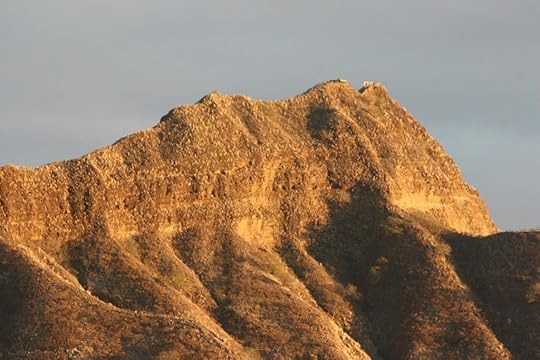
It wasn’t exact, but it was pretty darn close.
“Do you want to go here?” He asked me.
“Where is it? What is it?” I replied. He chuckled.
“It’s Hawaii, and that’s a pretty good drawing.”
Seven years later he would call me to his bedside. His body was weak, ravaged by numerous tumors and ninety pounds lighter than his normal weight. The strong mind he once had was now in another place.
“Son, come here,” he managed to utter between coughing fits. I went to his side, where he waved a hand at me and with a twinkle in his eye and strength in his heart he spoke out, “closer.” I put my face next to his. He grabbed my face between his feeble hands and looked at me with a tear in his eye.
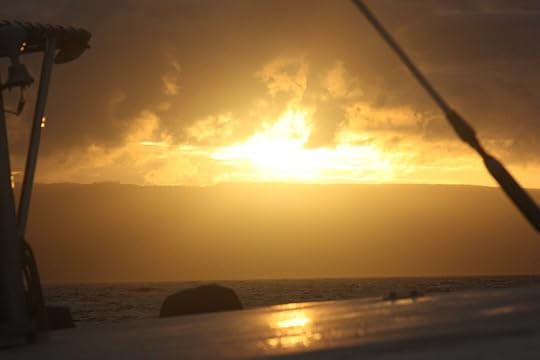
“Son, life is too short. Go see the world.”
He then kissed my cheek and hugged me as best he could. The next day the man who taught me right from wrong, the man who gave me the greatest advice on his deathbed, was gone. One month later I began what would become a lifetime journey to see the world. It started in Hawaii and would eventually span five continents, countless countries, close calls, life, death and love.
To be a part of this world you first need to understand it. To understand it you need to live it, not just read about it. Traveling encompasses so many conditions. Maybe we’re an art major, or we like to cook and drink wine, so we base our travel plans on those conditions. It could be the displacement of family, friends, or lovers. It might be the simplicity of just relaxing and do nothing. For me it was always the human condition and that sense of déjà vu. So many times my emotions outweighed my thought process. Wherever I went I had to go at all cost, as if my soul was calling out from ages past. As I’ve gotten older and look back at all the places I’ve been to and what has happened it all makes more sense.
Lying down in my bunk watching the moonlight on a night train from Rome to the deep south of Italy back in November of 2000 I had no real plan, but I knew it felt right. I was headed to a place that had captivated my imagination and where hardly anybody spoke English. It was the perfect place to get lost.
“The Dream Begins.” November 13th, 2000.
On a night train from Rome headed southeast all I could think about was the description of the place I would call home for what I thought would be the next two months.
“If you want to write a story come to where I am from,” said Sergio.
I met Sergio in Florence the previous summer. He was visiting his ex-girlfriend, who I had also met through a mutual friend. This group of friends, all Italians, had become my main core of friends during my summer sojourn in the majestic Renaissance city. I won’t go into too many details here, but Sergio and I 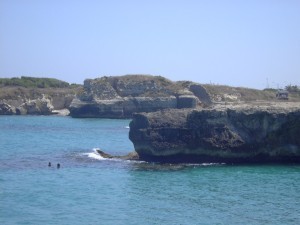 hit it off right away. He spoke some English, had lived abroad, was extremely intelligent and for some reason I felt he had been through some crazy things. When he told me I was invited to his home whenever I wanted to come it was intriguing.
hit it off right away. He spoke some English, had lived abroad, was extremely intelligent and for some reason I felt he had been through some crazy things. When he told me I was invited to his home whenever I wanted to come it was intriguing.
“You must come. The seawater is as the Caribbean.
The people are warm and the women have olive skin, long dark hair and their beauty is like no other. There is great food and great wine and the land is red. You will be inspired like a Renaissance poet was with his beloved Firenze.”
I wanted to go right then and there, but timing was everything and that summer timing was not on my side.
Coming Soon: “The Dream Begins,” Continued.
Read all the articles in this series.
The post “The Dream Begins,” Italy: Blood and Sacrifice Part 5 appeared first on We Said Go Travel.
March 28, 2015
Wine Harvest In Champagne – Through The Eyes of The Grape Pickers
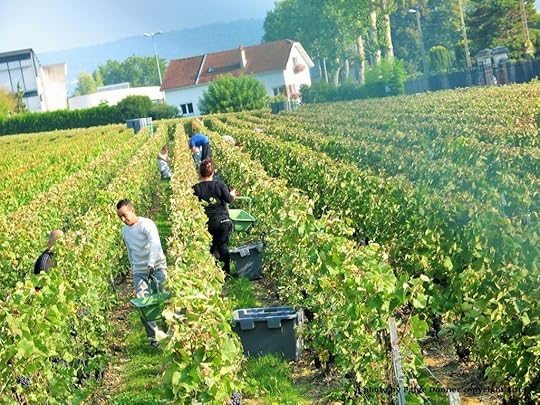 Champagne Harvest, France photo by Paige Donner copyright 2014
Champagne Harvest, France photo by Paige Donner copyright 2014by Paige Donner
Vendangeur is what a grape picker in France is called. And if you enjoy drinking your champagne and your Beaujolais, these people are your heros.
Many of us in the United States still harbor romantic notions of experiencing a wine harvest, preferably in the vineyards, joyfully picking grapes from morning ‘til dusk with a friendly group of brethren. Those dreams are completely unrealistic, especially in Champagne.
In Champagne harvest is industrialized, even if the picking is still done by hand. At least 100,000 pairs of hands are needed to harvest the grapes quickly during the one to two weeks when the annual harvest takes place. Time is very much of the essence as there really are only a few days when the grapes are optimal for picking. Busloads of grape pickers, mostly from Eastern Europe as well as large groups of Senegalese and other French-speaking Africans from Parisian suburbs, are brought in to the region just before harvest begins and are then quickly bussed out of the region after harvest ends.
Épernay, whose temporary harvest employment office operates as one of the main regional hubs doling out harvesting jobs, administered roughly 3,500 jobs and job-seekers during the first few days of harvest in Champagne in 2014. Pickers earn an average of about €9 per hour.
Oswald and Lina, two young Lithuanian students, who declined to have their photos taken, came for the romance of the experience. Oswald did the harvest last season (2013) in Champagne’s Aube region near Troyes, and this year brought his girlfriend Lina, a young architecural student, along with him to experience “the beautiful French countryside, the small charming towns and the quaint old churches.”
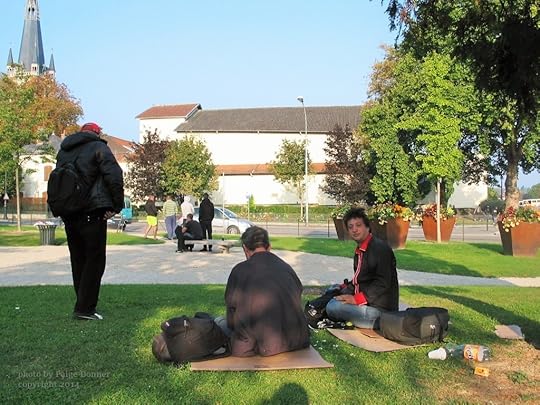 The tough conditions of the Vendangeur (grape picker) in Champagne. photo by Paige Donner copyright 2014
The tough conditions of the Vendangeur (grape picker) in Champagne. photo by Paige Donner copyright 2014The morning I spoke with them, Lina and Oswald had spent two nights sleeping in the park along with hordes of other hopeful harvesters who had also just arrived. Harvest had started only the day before. Lina was eager for a hot shower. Another couple, also Lithuanians, were taking her to the Red Cross which had set up hot showers and sanitary facilities for the few days of harvest period. I mentioned to them the modern public pool with hot showers at the far end of town. It was the first they’d heard about it.
According to Jean-Marc Biehler, a local resident of Mardeuil, a small village just near Hautvillers, where the famous Dom Perignon Abbey perches, explained that when he and his professor-wife were still students at university, they worked several harvests to earn extra money just before going back to « uni ». But now, in the past 10 or 15 years, university starts earlier and earlier in France, before harvest. This is why, he said, you don’t see many French people doing the picking in the Champagne vineyards these days.
Carole Grenier, who ran the the temporary harvest employment offices in Epernay for 2014, and her assistant, Charlene Tonnellier, explained that more and more in recent years the employment contracts go to large enterprises who loan out their workforce during harvest time. So rather than finding or filling jobs for individuals, she, for the most part, fills job contracts for 50 to several hundred people at a time. And this is all done through middlemen and labor brokers.
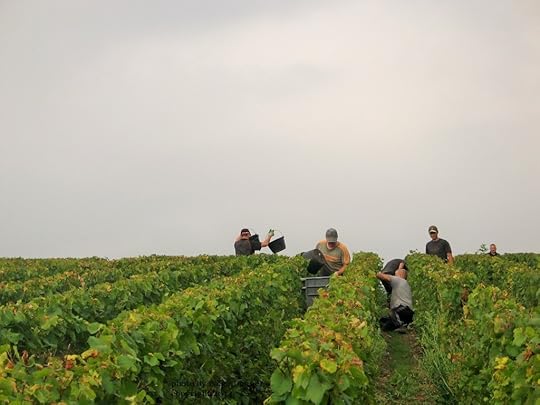 Champagne harvest, France. Photo by Paige Donner copyright 2014
Champagne harvest, France. Photo by Paige Donner copyright 2014When I asked if harvest in Champagne is any more difficult than anywhere else, she replied, “Yes, it is. Champagne grapes grow low to the ground, so it’s hard on the pickers’ backs. It’s days of backbreaking work spent stooped over.” She also explained that food and lodging is provided less and less because of the social costs involved. “If you find a harvest job that provides you with lodging, you have done very well and been very lucky,” said Grenier.
The best advice for anyone who still wants to experience picking grapes during harvest time in France ? Go to Burgundy. It is much less industrialized and you are more likely to find small operations that are still run more like a family. One operator that offers his services to travelers wanting this harvest experience is Netherlands-based Appellation Controlée.
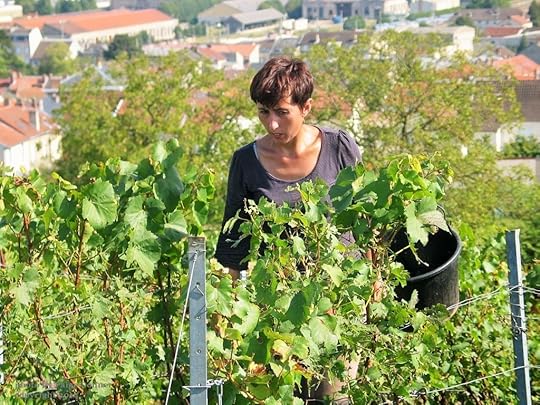 Champagne harvest, France. Photo by Paige Donner copyright 2014
Champagne harvest, France. Photo by Paige Donner copyright 2014Sidebar 1
Hand Harvesting vs. Mechanized Harvesting
There are really only two regions left in France where picking grapes by hand is the law : Champagne and Beaujolais. All the other AOC’s and regions allow for mechanized picking.
In Champagne, just Northeast of Paris where AOC champagne grapes grow, you will see no machines harvesting grapes in the vineyards. Nary a one.
Why ? Because, it is against AOC regulations. Still. Which means that if you own a champagne vineyard and don’t abide by the strict, and strictly enforced, regulations, you can’t sell your wine with the golden little label of “champagne” on it.
Since last year, however, there has been much discussion about whether Champagne, as a viticultural region, will allow for mechanized picking. The community is divided. The die-hards say that it will be the last region to keep its harvest-by-hand customs. This is because they can afford hand-harvesting, what with the prices they get for their grapes. And because champagne grapes are so delicate, with most of them being pressed for their juice right in the vineyards, just after picking. This yields the best quality juice, it’s said. Which makes for the best champagne, goes the local wisdom. In fact, there are 3,100 pressoirs or grape presses, spread throughout the vineyards of the 319 grape growing Champagne villages. This is for the roughly 403 million kilos of grapes harvested per year.
But the more modern-oriented grower-champagne producers and even some of the big négociants seem to be leaning towards mechanization. Why ? For one it will limit the influx of the 100,000 itinerant workers-grape pickers who “invade” the region every year. It will also cut down on the ” extravagant ” social costs that the champagne houses and vineyard owners pay to employ the pickers (legally) each year.
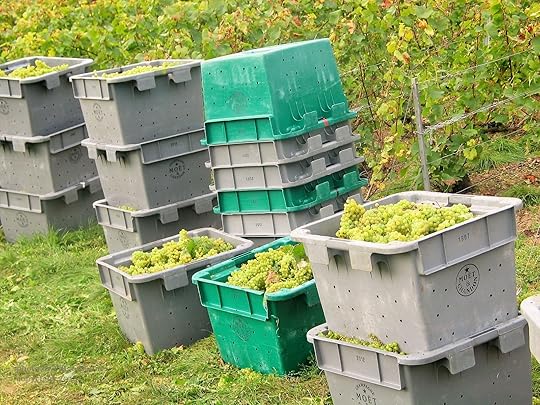 Champagne harvest, France. Photo by Paige Donner copyright 2014
Champagne harvest, France. Photo by Paige Donner copyright 2014Sidebar 2
The Business of Champagne
Just a few facts and figures to set the stage for grape-picking at harvest time in Champagne, France :
First of all, Champagne is one of the few wine regions in the world where the people who grow the grapes used for the winemaking make a good living. Not only do they make a good living, with little or no government subsidy required as is the case for much of the world’s wine regions, they make an average of about four times as much as other profitable winemaking regions, like Napa. “Here in Champagne we are just simple farmers. Rich farmers, though, to be sure,” commented Cyril Janisson, fifth generation champagne producer, vineyard owner and native Champenois who heads the champagne house Janisson Baradon & Fils.
In 2013 there were 304.9 million bottles of champagne sold worldwide. That represents $5.4 billion global sales worth of champagne. Champagne is big business.
This year, 2014, champagne producers are aiming to reach a total sales output of 307 million bottles worldwide.
And none of this, not one drop of this golden elixir, would exist if it weren’t for the grapepickers, the « vendangeurs » as they are called in French.
Champagne grapes are the most expensive grapes in the world. The 2014 price per kilo was set at between €5.17 and €6.06 depending on the village the grapes are grown in. In Champagne there is a hierarchical classification of the villages with the top-shelf grapes coming from the Grand Cru villages such as Aÿ, Le Mesnil-sur-Oger and Ambonnay. The next tier are the Premier Cru villages and then there’s all the rest.
Sidebar 3
Champagne by the Numbers
There are 319 villages that are authorized as champagne grape growing villages in Champagne. This authorization comes from the CIVC (Comité Interprofessionnel du vin de Champagne), the Champagne Bureau who makes all the rules and enforces them. In fact, in Champagne, you don’t even have the right to harvest your grapes until the CIVC decrees that you can. The dates each year are set village by village by this God-like trade organization. They go back quite a ways, too. Champagne was one of the first wine regions – on Earth – to lobby for and get AOC status. So these guys are the big boys and they regulate the big business of champagne.
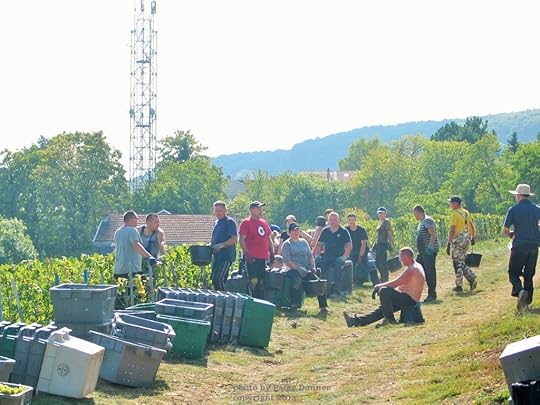 Champagne harvest, France. Photo by Paige Donner copyright 2014
Champagne harvest, France. Photo by Paige Donner copyright 2014A few more numbers :
There are
33,571 hectares (82,956 acres) of vines in production in Champagne
15807 parcels of vines
13,648 vineyard owners, of which more than half cultivate less than one hectare of vineyards
13104 vineyard owners sell their grapes
4629 vineyard owners commercialize their own champagne (that accounts for 65.7 million bottles)
135 co-operatives for champagne grape growers
43 co-operatives commercialize their own champagne (28.3 million bottles)
392 négociants (the licensed agents authorized to buy grapes and sell bottles of champagne on the market, these include the big houses such as Roederer, Bollinger, Lanson, Moët, etc.) which account for 210.9 million bottles of champagne
Of the 304.9 million bottles of champagne sold globally in 2013,
167.3 million sold in France
74.7 million sold in the EU
62.9 million sold in the rest of the world
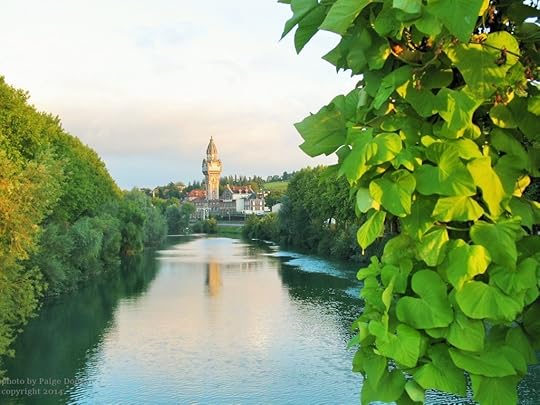 Champagne harvest, France. Photo by Paige Donner copyright 2014
Champagne harvest, France. Photo by Paige Donner copyright 2014Sidebar 4
If You Go
I recommend staying in the lovely little Grand Cru village of Aÿ, France. It is situated between Reims and Epernay in the Montagne de Reims. Chamapagnes Bollinger, Deutz and Collet call the village home among dozens of other fine champagne producing houses.
The easiest way to get there is to fly into Paris. From Paris take the fast train, the TGV, to Reims, which is about 45 minutes or the slower train, the TER, to Epernay which is an hour and 15 minutes. Both leave from the Gare de l’Est in northern, central Paris.
Round-trip tickets Paris-Epernay cost €48.20 for adult, second-class fare ; Roundtrip Paris-Reims on the TGV varies in price from about €60 to €85 for adult second-class. Aÿ is a short 5 minute taxi ride from Epernay, another €10. From Reims a taxi to Aÿ will cost at least €30. There is a charming commuter train that connects Reims and Epernay which stops in Aÿ: €7.50 Reims to Aÿ. But the train departs only a couple of times a day so check schedules.
Where To Stay
There are at least three very good accommodations to choose from in Aÿ. The hotel Castel-Jeanson is owned by the Goutorbe champagne family and the renovations they’ve done to this property are extensive and even include an indoor swimming pool. From €127 – €225
Hotel Castel Jeanson 24 bis rue Jeanson casteljeanson.fr +33 326 542 175
For a homey, B&B experience, the Clos St. Georges is a gated estate. It has a separate little honeymooner’s cottage on the property in addition to its six rooms. Eric and Sylvie Aubert also offer one of the best tables for lunch and dinner in the region. €98-€150
Le Clos St. Georges 7, rue Jules Lobet Aÿ, France levieuxpuits.com +33 326 569 653
Just opened in time for 2014’s harvest is the Champagne Sacret Chambres d’hôtes. In addition to the B&B’s stylish décor and the smell of fresh paint, you have the added thrill of staying on a working champagne estate where the wine is vinifying in vats underneath you. €150-€200
Champagne Sacret chambres d’hôtes 3, rue Billecart Aÿ, France Champagne-sacret.com + 33 326 569 920
Where to Eat
In addition to Le Vieux Puits at Le Clos St. Georges, mentioned above, there is also La Maison du Vigneron and L’Assiette Champenoise. The latter (€200 pp with wine) got its third Michelin star last year and the former is a solid and simple country kitchen restaurant (appetizers €15, mains €30, deserts €12).
La Maison du Vigneron RD 951 Saint-Imoges lamaisonduvigneron.com +33 326 528 800
L’Assiette Champenoise 40, Avenue Paul Vaillant-Couturier Tinqueux assiettechampenoise.com +33 326 846 464 (Closed M, T , W)
To Learn More
There are several local tour guides based in the region. All are good, but Cris has been doing it the longest.
Cristourschampagne-ardenne.com +33 326 882 637
Brand new in Champagne is the Cité du Champagne. This historical and cultural center’s exhibit offers museum-worthy artifacts and photos and a cellar tour. Not to miss.
Cité du Champagne 14 Boulevard Pasteur Aÿ, France champagne-collet.com
+33 326 551 588
Consult these regional office of tourism sites for more information : http://www.tourisme-en-champagne.com/en, http://www.ay-champagne.fr/index.adml?r=235,
 Paige Donner French wine, food and travel expert. copyright 2014
Paige Donner French wine, food and travel expert. copyright 2014Paige Donner is certified champagne expert (by the CIVC) and writes regularly for USA Today and 10BEST.com as their Paris and France Travel Expert writer/photographer/editor. Contact her at About.me/paigedonner.
The post Wine Harvest In Champagne – Through The Eyes of The Grape Pickers appeared first on We Said Go Travel.
We Said Go Travel
We Said Go Travel is a global community of over sixteen hundred writers with articles from every continent.
Stories are shared with photos and video from a perspective of the transformative power of travel. We Said Go Travel has hosted live and online events as well as travel writing contests around the world. ...more
- Lisa Niver's profile
- 57 followers



